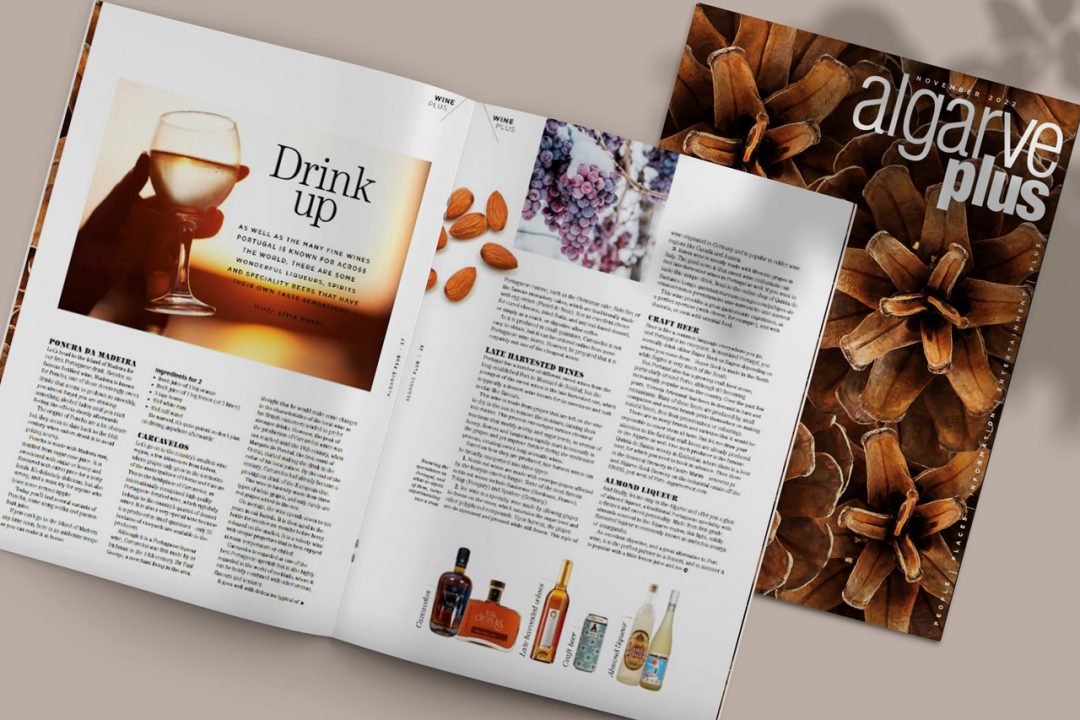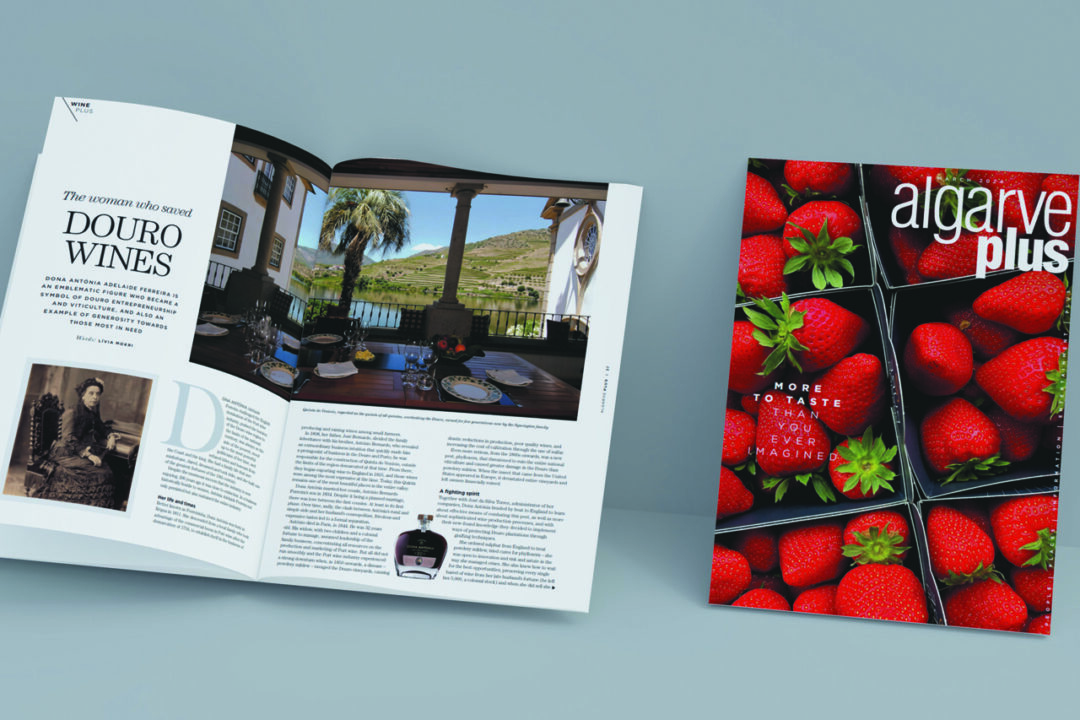Drink Up! – Portuguese cuisine is more often than not at the forefront when discussing things to try out in Portugal, and not surprisingly the Portuguese wines too.
As well as the many fine wines Portugal is known for across the world, there are some wonderful alcoholic drinks that have their own taste sensations, suited to every taste and preference.
That’s why I decided to write you about some unique types of Portuguese drinks that you simply have to give a try in this beautiful country!
Hopefully, this guide inspires you to give these a try as well besides your favorite wines!
I am happy to share that my new article in the Algarve Plus Magazine has already been published!
The magazine is readable online or downloaded for free here.
Enjoy!
Or read here the whole article:
Drink up
Portuguese cuisine is more often than not at the forefront when discussing things to try out in Portugal, and not surprisingly, the Portuguese wines do get much of a mention as well.
But ever wondered what Portugal has to offer by way of Portuguese alcoholic drinks and spirits besides the still wines?
That’s why I decided to write you about some other different types of Portuguese drinks that you simply have to give a try in this beautiful country!
Following are some of my recommendations for other popular Portuguese alcoholic drinks!
PONCHA DA MADEIRA
First, we head to the Island of Madeira for our first Portuguese drink. Besides its famous fortified wine, Madeira is famous for Poncha. Poncha is one of those deceiving sweet drinks that seems to go down so smoothly, you almost forget you are drinking quite an alcoholic drink until you start feeling the effects shortly after.
The origins of Poncha are a bit obscure but they seem to date back to the 16th century when sailors drank it to avoid scurvy.
Poncha is made with Madeira rum, distilled from sugar cane juice. It is sweetened with sugar or honey and flavored with citrus juice for a zesty finish. It’s definitely delicious, but also strong, and a must-try for anyone who loves a tipple!
Today you’ll find several variants of this drink (using vodka and passion fruit juice, for example).
If you can’t go to the Island of Madeira any time soon, here is an authentic recipe so you can make it at home:
Ingredients for 2:
- fresh juice of 1 big orange
- fresh juice of 1 big lemon (or 2 limes)
- 3 teaspoons of honey
- 40 cl of white (Madeira or any) rum
- 40 cl of still water
Be warned, it’s quite potent so don’t plan on driving anywhere afterward!
CARCAVELOS
Let’s go on to the country’s smallest wine region, a few kilometers from Lisbon, whose grapes only grow in the territories of the municipalities of Oeiras and Cascais. This is the birthplace of the Carcavelos, an internationally recognized Portuguese fortified wine, which, with its high quality, rightfully belongs to the country’s quartet of dessert wines. It is also a very special wine because it is produced in small quantities, only 25 hectares of vineyards are available to the producers.
Although it is a Portuguese liqueur wine, it was first made by an Irishman in the 14th century. Sir Paul George, a merchant living in the area, thought that he would make some changes to the characteristics of the local wine, as his British customers tended to prefer liquorier, stronger drinks. However, the peak of the production of Carcavelos wines was not reached until the 18th century, when Marquês de Pombal, the first count of Oeiras, started making the drink in the cellar of his local palace. By the end of the century, Carcavelos had already become a prestigious drink of the European elite.
This wine is basically made from three types of white grapes, but rarely, red grapes can also be added to the wine.
On average, the wine spends 7-10 years in oak barrels. It is then aged in the bottle for another 6 months before being released on the market. A velvety wine with unique properties that are best enjoyed at room temperature or chilled.
It is considered one of the best Portuguese aperitifs but is also excellent in the world of cocktails, where it can be boldly combined with other aromas, flavors, and textures.
The Carcavelos goes well with delicacies typical of Portuguese cuisines, such as the Christmas cake called Bolo Rei, or the famous monastery cakes, which are traditionally made with egg cream (see Pastel de Nata). It is an excellent choice for cured cheeses, dried fruits, and any nut-based dessert, or simply as a snack or digestion after coffee.
Since it is produced in small quantities, it is not easy to obtain, but it can be ordered online from some Portuguese wine stores. However, be prepared for the fact that it is not one of the cheapest wines.
LATE HARVESTED WINES
Portugal has some different sweet wines from the famous Port to Moscatel de Setúbal. But the most recent type of these wines is the late-harvested one, which is typically a dessert wine known for its sweetness and lush nectar-like flavors.
This wine is made from grapes that are left on the vine to dry in the sun. The process dries out the moisture from the fruit, turning it into raisins. This phenomenon provokes various chemical reactions that modify parameters like acidity and sugar levels. So aromas of honey, flowers, and tangerines rapidly start to intensify in the grapes and get better during the vinification process, creating sweet long aromatic wines.
Based on how they are produced, late-harvest wines can be broadly categorized into three types:
- Noble rot wines are made with overripe grapes affected by the botrytis cinerea fungus. Some of the most famous noble rot wines include Sauternes (Bordeaux, France), Tokaji (Hungary), and Spätlese (Germany).
- Ice wine, which is a specialty wine made from grapes allowed to freeze on the vines. Freezing saturates the grape’s sugar level and other polyphenol compounds. Upon harvest, the grapes are de-stemmed and pressed while still frozen. This style of wine originated in Germany and is popular in colder wine regions like Canada and Austria.
- Raisin wine, which is made from grapes that are left on the vine to dry in the sun. The process dries out the moisture from the fruit, turning it into raisins. It’s usually made with Moscato grapes in Italy.
And the good news is that sweet wine enthusiasts can find late-harvested wines in Portugal as well. Even in the Algarve! If you want to taste this unique drink, head to the online shop of Quinta do Barranco Longo where you can order some bottles for your home.
This wine provides a great gastronomical experience, as a perfect aperitive (with cheeses, for example), and with deserts, or even with oriental food.
CRAFT BEER
Beer is like a common language everywhere you go, and Portugal is no exception to this rule. In mainland Portugal, you normally drink either Super Bock or Sagres depending on where you come from. Super Bock is made in the North so is more popular there, while Sagres is more popular in the South.
But Portugal also has a growing craft beer scene, particularly around Porto although it’s becoming more and more popular across the country as well. Over the past few years, the words ‘Cerveja artisanal’ (craft beer) have become increasingly popular in bars and restaurants.
Many of these beers are produced by small companies and several brands pride themselves on making natural beers, free from preservatives or colorings.
There are so many brands and varieties that it would be impossible to cover them all here. But let me draw your attention to the fact that craft beers are already produced in the Algarve as well. One such producer is the famous Quinta de Santos winery in Estômbar, where you can take part in a separate beer tour too, after booking an appointment in advance. The other one is the Senescal Brewery which operates in Castro Marim.
ALMOND LIQUEUR
And finally, let me stay in the Algarve and offer you another popular alcoholic drink.
The almond liqueur is yet another of the traditional Portuguese drinks that are definitely worth giving a go in Portugal. It is made from first-grade almonds sourced in the Algarve region in southern Portugal. Most commonly known as ‘amêndoa amarga’ or ‘amarguinha’.
This light, mildly flavored liqueur is excellent as a digestive, and a great alternative to Port Wine, for example, but even suited to enjoying with a dessert after a lovely Portuguese meal!
In summer it is nice to drink it with a little lemon juice and ice.
Since it is a very popular drink, you can even find good examples in a supermarket as well.
As far as Portuguese alcohol and drinks go, there’s a wide variety to choose from, suited to every taste and preference.
Hopefully, this guide has inspired you to give these a try as well besides your favorite wines!






No Comments Found